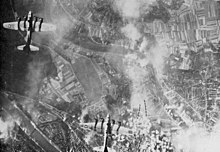Koblenz-Mosel depot
The original depot Koblenz-Mosel was a depot on the Moselle route in Koblenz . The plant, located between the districts of Moselweiß and Goldgrube , was in operation from 1900 to 1988. The locomotive shed was the home and repair site of locomotives of the German Federal Railroad (DB) and its predecessor railways . In the Koblenz area, passenger trains were only hauled here.
The buildings of the Deutsche Bundesbahn were completely demolished. From 2008 trans regio built its own Koblenz-Mosel depot at the same location.
history
The Moselle route, which opened on May 15, 1879, ended in Koblenz at the Moselle train station , near today's main train station . Another station was the Rheinbahnhof for trains on the left Rhine route . After the Prussian city fortifications were abandoned in 1890, the city of Koblenz was able to break out of the narrow city limits for the first time. Both existing train stations were combined with the construction of the main train station in 1902 and given up.
This went hand in hand with a complete renovation of the Koblenz railway system. It emerged three operating workshops, one at the main railway station, depot Koblenz-Lützel at the station Koblenz-Lützel (1905) and another on the Moselle track in Moselweiß (Koblenz-Mosel). The construction work for the construction of the Koblenz-Mosel depot began in 1896 by the Coeln Railway Directorate . After commissioning around 1900, the plant was completed in 1902.

After the First World War and the occupation of the Rhineland , the economic situation was very difficult and there was hardly any investment in modern locomotives. The first improvement came in 1927 with the four-track expansion of the Moselle railway bridge . With the abandonment of the depot at Koblenz main station in 1935, the services were taken over by the depot Koblenz-Lützel and Koblenz-Mosel. With the construction of the west wall from 1938 onwards, considerable amounts of building materials were transshipped via the Koblenz-Mosel depot. During the Second World War , the plant was usually the main target of the Allied air raids on Koblenz . In 1944/1945, troops and material were brought to the Western Front via the important railway junction in Koblenz . The air raids on the depot reached a final climax with the German Ardennes offensive . Shortly before the American troops marched in in March 1945, many operational locomotives were brought to safety in the “interior of the Reich”. Operations at the plant finally came to a complete standstill with the destruction of all bridges in Koblenz on March 7, 1945 by the withdrawing units of the Wehrmacht .
American troops resumed rail traffic from Koblenz-Mosel via Bonn to Aachen on March 29, 1945 for their own supplies. The Moselle railway bridge was provisionally restored. The repair of the Moselle route was more difficult because too many bridges along the Moselle were destroyed. The route over the Güls railway bridge to Güls was provisionally open again on December 18, 1945, but the entire route to Trier could not be made navigable again until May 1947.
With the takeover of Koblenz by the French military administration , the Koblenz-Mosel depot was subdivided from the former Reichsbahndirektion Cologne to the railway directorate Mainz. After its dissolution on June 1, 1971, the plant came back into the care of the Cologne directorate. A further normalization of the conditions in the plant after the war took place with the takeover by the Deutsche Bundesbahn and the return of locomotives.
The first losses in the use of steam locomotives were noticeable after the electrification of the left Rhine route in 1958. In 1962 the right Rhine route was electrified , and in 1973 that of the Moselle route, which meant the end of steam operation (see also the chronicle of the electrification of the Deutsche Bundesbahn ). The Koblenz-Mosel depot was gradually converted to the maintenance of electric locomotives . The end came after the "Betriebswerk Koblenz" department at the main train station went into service on May 1, 1982. From now on, more and more employees and vehicles were moved to the new depot, for example the locomotive management in 1982. The Koblenz-Lützel train station was also affected. The last railcars left the Koblenz-Mosel depot on May 28, 1988. The company buildings had since been abandoned and were demolished by 2007.
Operating facilities

The Koblenz-Mosel depot was located between Beatusstraße / Bogenstraße and the Moselle line . There was a direct connection to the Moselle route, from where the Koblenz main train station could be reached directly via the left Rhine route. The heart of the system on the west side was a 30-person roundhouse with a turntable . After the war, there were 25 stands left until they were demolished, 5 stands were designed as free stands. In addition, there was a water tower with a water crane and slag pit, a coal bansen, a transformer house, a sanding plant and various administrative buildings, e.g. B. for the engine management. During the Second World War, two bunkers were built at the plant to protect Reichsbahn workers in the event of air raids .
Trans Regio depot Koblenz-Mosel
On the former site of the German Federal Railways the established trans regio German regional railway GmbH since 2008 its own depot with workshop and depot . Here the vehicles are 460 series of the type Desiro ML serviced.
literature
- Matthias Fuhrmann (Ed.): The Bw Koblenz-Mosel. In: Deutsche Bahnbetriebswerke and the locomotive fleet of the German railways from 1920 to today. GeraMond Verlag Munich, 1991
Web links
- Photos from the Koblenz-Mosel depot in the forum Drehscheibe-online.ist-im-web.de
- More photos with a map on ahrtalbahn.de
- Trans Regio depot Koblenz-Mosel
Coordinates: 50 ° 21 '8 " N , 7 ° 33' 54" E

